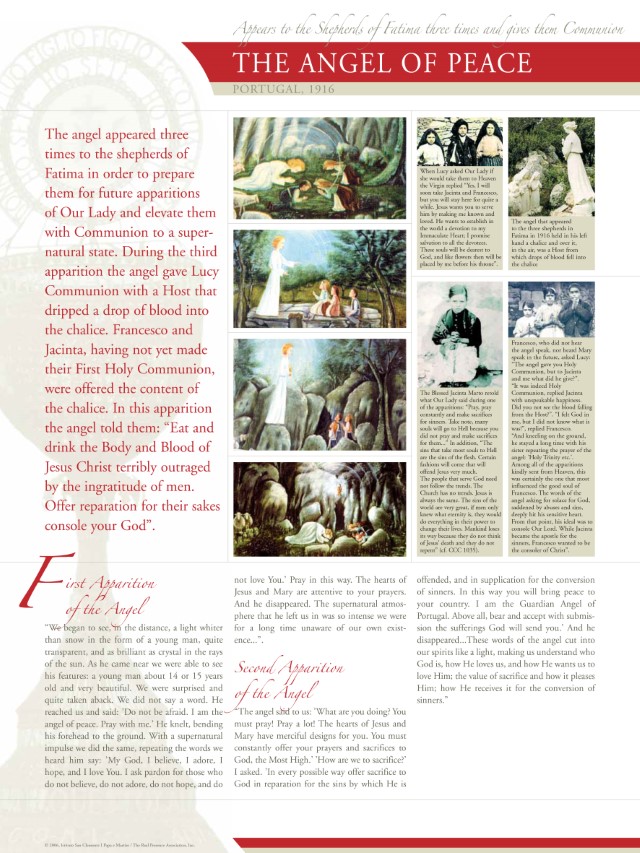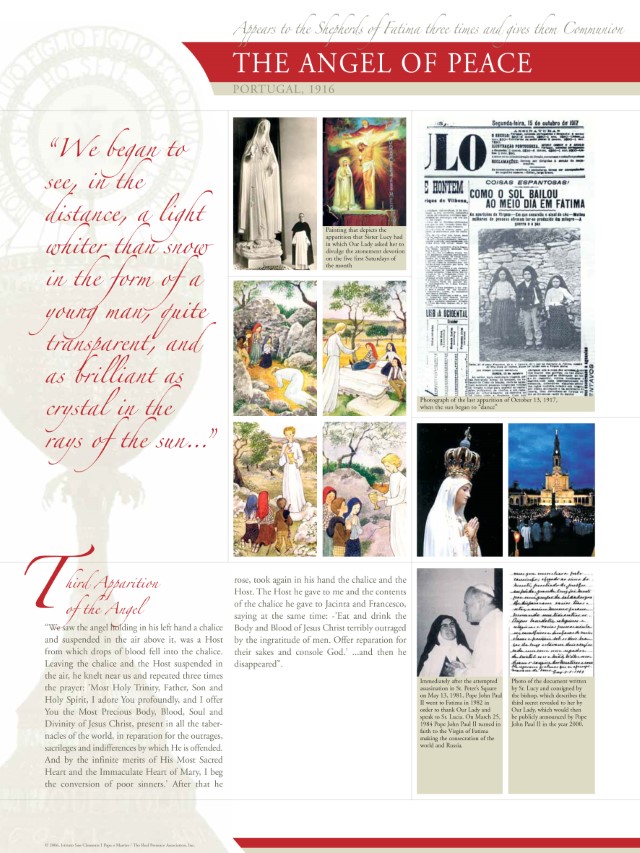Mary and the Eucharist
Mary also anticipated, in the mystery of the incarnation, the Church’s Eucharistic faith. When, at the Visitation, she bore in her womb the Word made flesh, she became in some way a “tabernacle” – the first “tabernacle” in history – in which the Son of God, still invisible to our human gaze, allowed himself to be adored by Elizabeth, radiating his light as it were through the eyes and the voice of Mary.
(St. John Paul II, Ecclesia de Eucharistia, 55)
Learn more about Mary and the Eucharist by praying the Joyful mysteries of the Holy Rosary and the stories listed below.
Pray the Holy Rosary - The Joyful Mysteries
The steps to praying the Rosary
- Make the Sign of the Cross and say the “Apostles’ Creed”
- Say the “Our Father”
- Say three “Hail Marys” for Faith, Hope, and Charity
- Say the “Glory Be”
- Announce the First Mystery and then say the “Our Father”
Say ten “Hail Marys” while meditating on the Mystery
Say the “Glory Be” (Optional: Say the “O My Jesus” prayer requested by Mary at Fatima) - Announce the Next Mystery; then say the “Our Father” and repeat these steps (6 through 8) as you continue through the remaining Mysteries.
- Say the closing prayers: the “Hail Holy Queen” and “Final Prayer”
- Make the “Sign of the Cross”

The First Mystery
The Annunciation

The Second Mystery
The Visitation

The Third Mystery
The Nativity of Jesus

The Fourth Mystery
The Presentation

The Fifth Mystery
Finding Jesus in The Temple
Please click on one of the buttons below to read more about the stories.
Fatima Story - The Angel of Peace

Please click on the images below to read.
Our Lady of Guadalupe
Please click presentation mode to view in full screen.
Our Lady of Guadalupe and Miracles of the tilma

Our Lady of Guadalupe Explained
- The Black Cross: The black cross displayed on the gold brooch at her neck is identical to the one emblazoned on the banners and helmets of the Spanish soldiers, as if telling the Aztecs that her religious was synonymous with that of the conquerors.
- The Stars on Her Mantle: The stars strewn across her mantle imply that the Lady is greater than the stars in the sky, which the Aztecs worshipped as gods. Yes, she is not confused with being a god, since her hands are joined in prayers, and her head is bowed in reverence, clearly to One greater than herself. Also, the position of the stars correspond exactly as they were positioned before dawn on the morning of December 12th, 1531 during the winter solstice, which was the very day that the Lady appeared to Juan Diego for the first time.
- The Black Ribbon: The black ribbon, or tassel tied in a knot, indicates that she is a noble woman who is pregnant. For the Aztecs, the trapezoid-shaped ends of the ribbon signify the end of one cycle of time and the birth of a new era.
- The Tunic: The Blessed Mother’s tunic is pink with shades of crimson, representing the Earth. There are nine Tepetl flowers on the tunic. Heart-shaped and in the form of scrolls, these flowers seem to speak and sing symbolizing that it is giving a universal message for mankind. This type of flower is considered to be the Mexican magnolia, or “yolloxochitl,” meaning “heart” and “flower” in Nahuatl. This word was used by the Aztecs to denote a palpitating heart, which they removed from their victims during rituals of human sacrifice. They offered these to please their sun god, who would in turn, keep the universe alive, protecting it from the war raging between the sun and the moon and the stars. They believed that the sun was at war with the moon and the stars. Each flower has tips pointing to give directions: East, West, North, South and the highest point, shown as the “nose” of the flower. The “nose” on the Tepetl is said to represent Tepeyac, the hill where Juan Diego heard beautiful heavenly music and saw the Lady for the first time. The word “Tepeyac” means “Nose of the Hill.” The bottom of her tunic shows excess fabric edged in gold, just like her mantle. The pointed ends of the tunic and the mantle are held by an angel on each hand, symbolizing the union of Heaven and Earth.
- The Angel: The angel supporting the Lady testifies to her royalty. To the Aztecs, only kings, queens and other dignitaries would be carried on the shoulders of someone. The angel is transporting the Lady to the people as a sign that a new age has come. The angel resembles a native Indian, with its dark complexion. Its representation is not of a cherub, but of that of a young Eagle Warrior belonging to the Aztec army, known as “Solders of the Sun.” The angel is also said to represent Juan Diego, whose native name was “Cuauhtlatoztzin,” meaning “Eagle who speaks.”
- Brief History: In 1531, a “Lady from Heaven” appeared to a poor Indian named Juan Diego at Tepeyac, a hill northwest of Mexico City. She identified herself as the Mother of the True God and instructed him to have the bishop build a church on the site. The bishop demanded a sign from the Lady. In compliance with the bishop’s request, the Lady directed Juan to pick some roses (which were not in bloom then). Juan Diego gathered these roses in his tilma and brought them to the bishop. When he opened his tilma to let the roses fall to the floor, he found that his cloak had miraculously acquired an image of the Mother of God. This event brought about the conversion of over 9,000,000 Aztecs from the worship of false gods.
- The Blue-Green Mantle: The blue-green or turquoise hue of her mantle is the same color as that worn by Aztec royalty. Hence, she is considered by the Aztecs to be a queen, since only the Emperor wears this color.
- Rays of the Sun: Mary is standing in front of the sun. The Aztecs, who knew well how to read pictographs, interpreted this to mean that she was greater than the dreaded sun-god, Huitzilopochtli, whom the Aztecs called “the Lover of Hearts and Drinker of Blood.” Every major Aztec city had a temple pyramid, approximately 100 feet high, on top of which was erected an altar. Upon this altar, the Aztec priests offered human sacrifices by cutting out the beating hearts of their victims while still alive. As the victims perished, their hearts were held in front of their eyes. Then, the temple priest would hack off the victim’s arms and legs, throwing them to the crowd below, who would take them home to cook and eat. 50,000 human sacrifices took place each year. It is estimated that one out of every five children fell victim to this bloodthirsty ritual.
- The Four-Petelled Flower: The four-petalled flower is the only flower of its kind found on Our Lady’s robe. It is known as the “flower of the Quineunx” considered to be one of the highest religious and cosmogonic symbols of the Aztecs. It depicts the four movements of the sun (i.e., the four seasons) as well as the North, South, East and West united in the center by a fifth element, giving it balance and equilibrium. The strategic location of the flower over Our Lady’s womb is known to the Aztecs as “Nahui Ollin” (translated as “Flower of the Sun”), representing the motherhood of the Virgin. This image tells the Aztecs she is mother of the “child sun god” in her womb, who is the author and giver of life.
- The Crescent Moon: The crescent moon under her feet signifies the Aztec’s foremost deity, the feathered or stone serpent-god, Quetzalcoatl, whom the Aztecs worshipped as the god of night. By standing on the moon, she shows that she is more powerful than the god of darkness whom she vanquishes.
- Tilma Temperature: The temperature of Juan Diego’s tilma, made of a material that comes from fibers of the maguey cactus, maintains a constant temperature of 98 degrees, the same as the of a living human body.
- Tilma Material: The tilma is mad e of ayate fiber, a coarse fabric derived from the threads of the maguey cactus plant. The lifespan of the ayate fiber is approximately 20 years. Yet, after almost 500 years, the tilma does not show even the slightest sign of decay. Scientists have declared that there is no coloring of any kind in the fibers of the tilma. The materials used to produce these colors remain unknown to science, being neither animal, vegetable nor mineral dyes. Furthermore, a microscopic examination revealed that there are no brush strokes, indicating that the tilma is not a painting.
The Eucharist and Saint Catherine Laboure

Please click presentation mode to view in full screen.
Lourdes, France

Please click presentation mode to view in full screen.
St. Luis de Montfort on Mary and Holy Communion
The following is found at the end of St Louis de Montfort’s True Devotion to Mary, concerning how we ought to receive Holy Communion in union with Our Lady.
Before Receiving
Holy Communion
At Receiving
Holy Communion
After Receiving
Holy Communion




